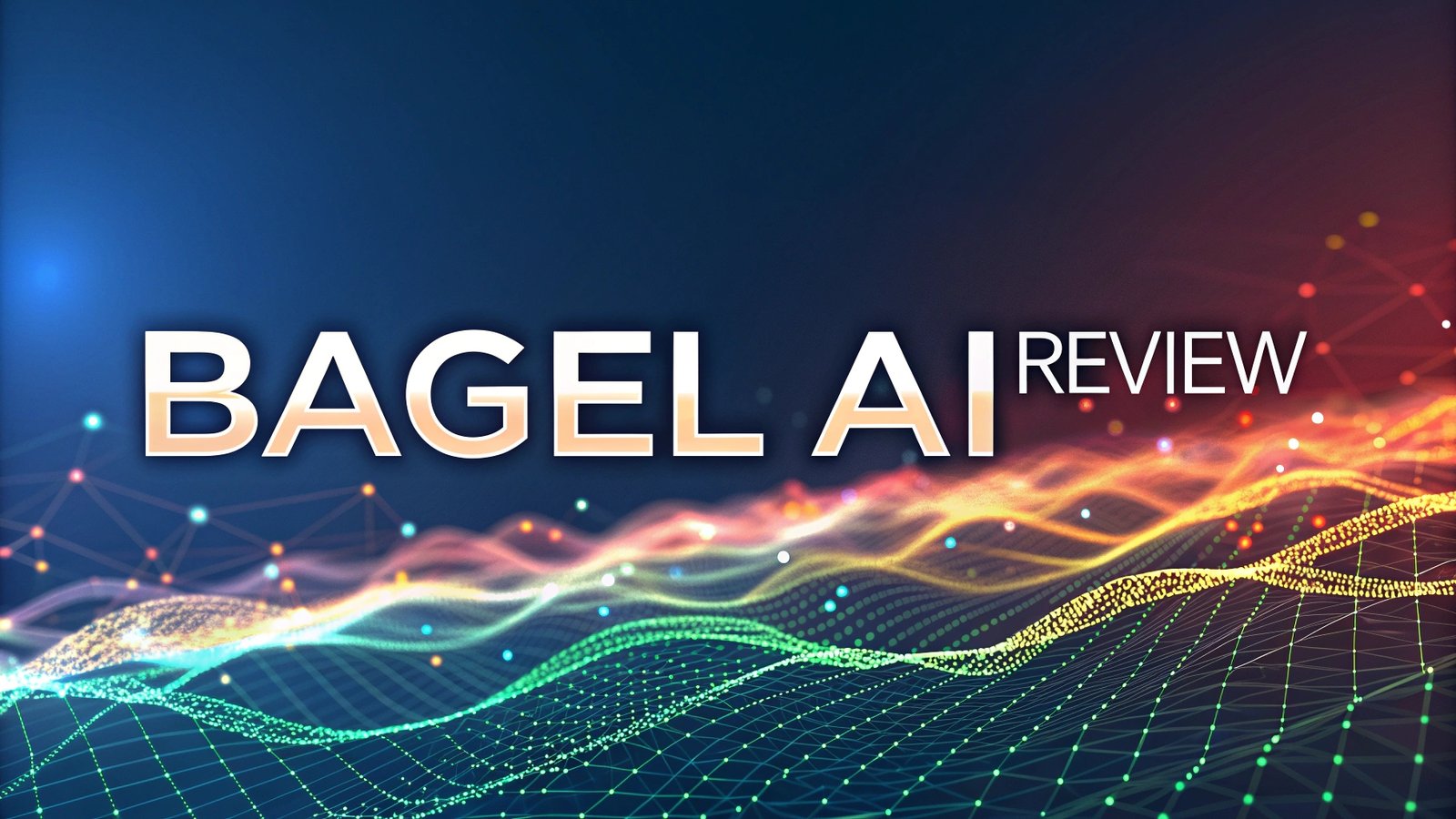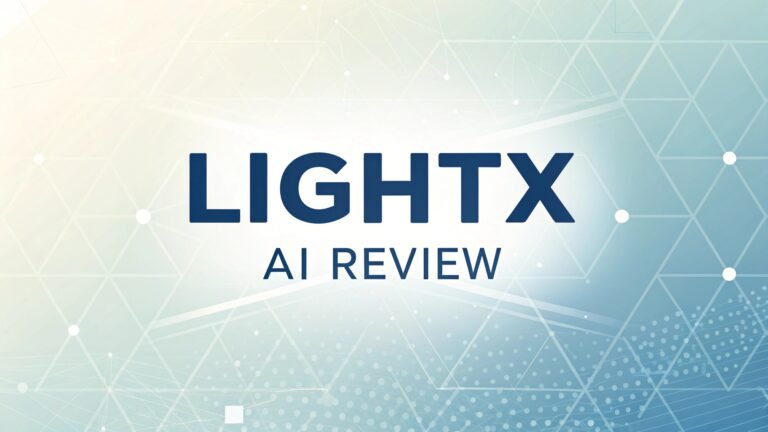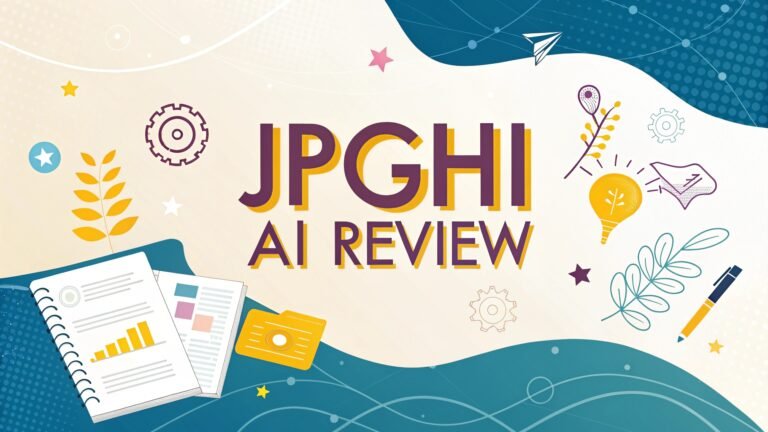BAGEL AI Review: The Complete Guide Multimodal AI
The world of artificial intelligence continues to evolve at lightning speed, and BAGEL AI has emerged as one of the most talked about platforms in 2025.
This comprehensive review explores everything you need to know about BAGEL AI, from its groundbreaking features to real world applications.
Whether you are a developer, business owner, or AI enthusiast, this guide will help you understand what makes BAGEL AI special and whether it deserves a place in your tech stack.

Key Takeaways
- BAGEL AI offers two distinct platforms: ByteDance’s open source multimodal model and a separate product intelligence platform for businesses
- The ByteDance BAGEL model excels at image generation, editing, and understanding with 7B active parameters and competitive performance against proprietary models
- BAGEL’s product intelligence platform helps businesses connect customer feedback to revenue outcomes and product decisions
- The open source nature of ByteDance BAGEL makes it accessible for developers and researchers without licensing costs
- Both platforms address different market needs with the multimodal model serving AI developers and the product platform targeting business teams
- Performance benchmarks show BAGEL competing effectively against established models like GPT 4 Vision and Gemini in specific tasks
What is BAGEL AI and Why Does It Matter
BAGEL AI represents a fascinating case study in AI branding confusion. Two completely separate platforms share the BAGEL AI name, serving different markets and purposes. The first is ByteDance’s open source multimodal foundation model, designed for developers and researchers who need advanced image and text processing capabilities. The second is a product intelligence platform that helps businesses make data driven product decisions.
ByteDance’s BAGEL model launched in May 2025 as an open source alternative to proprietary multimodal systems like GPT 4o and Gemini 2.0. The model uses a Mixture of Transformer Experts architecture with 7B active parameters out of 14B total, making it efficient while maintaining strong performance across various tasks.
The product intelligence platform, meanwhile, targets business teams who struggle with scattered customer feedback and unclear product priorities. This platform uses AI to extract insights from customer interactions and connect them to revenue outcomes, helping product managers make better decisions about what features to build next.
Both platforms address real market needs but serve completely different audiences. The confusion between these two offerings highlights the importance of clear branding in the AI space, where similar names can lead to significant misunderstandings about product capabilities and target markets.
BAGEL AI Multimodal Model Features and Capabilities
The ByteDance BAGEL multimodal model stands as one of the most impressive open source AI achievements of 2025. The model combines image generation, editing, and understanding capabilities in a single unified architecture. This integration allows users to perform complex visual tasks without switching between different specialized models.
Image generation capabilities in BAGEL produce high quality, photorealistic outputs that compete with commercial alternatives. The model can create images from text descriptions, maintaining consistency in style and subject matter across multiple generations. Users report that BAGEL’s image quality often matches or exceeds other open source alternatives available in 2025.
The editing features represent where BAGEL truly shines. The model can perform intelligent image modifications based on natural language instructions. Users can ask BAGEL to change specific objects, modify backgrounds, adjust lighting, or transform artistic styles while preserving the core composition and important details of the original image.
Visual understanding forms the foundation of BAGEL’s other capabilities. The model can analyze images, describe their contents, answer questions about visual elements, and reason about spatial relationships. This understanding enables more sophisticated editing and generation tasks that require contextual awareness.
The model’s unified architecture means these capabilities work together seamlessly. Users can engage in multi turn conversations about images, make iterative edits based on the model’s understanding, and generate new content that builds on previous interactions. This integration creates a more natural and efficient workflow for complex visual tasks.
BAGEL AI Product Intelligence Platform Overview
The BAGEL AI product intelligence platform addresses a critical problem facing modern businesses: the disconnect between customer feedback and product development decisions. Product teams often struggle to prioritize features because customer insights remain scattered across multiple tools and systems, making it difficult to understand what customers actually need and value.
Automatic evidence consolidation represents the platform’s core strength. The system continuously monitors customer interactions across tools like Salesforce, Gong, Zendesk, and Jira, using AI to identify and extract relevant product feedback. This automation eliminates the manual work typically required to gather and organize customer insights.
The platform bridges product decisions with revenue outcomes by connecting customer feedback to specific accounts and opportunities. Product managers can see not just what customers want, but which requests come from high value accounts and how addressing specific issues might impact revenue. This connection helps teams prioritize features based on business impact rather than just frequency of requests.
AI generated roadmap suggestions provide another valuable capability. The platform analyzes existing roadmaps, customer feedback patterns, and usage data to suggest new product ideas that align with customer needs and business goals. These suggestions include context about potential impact and implementation considerations.
Real time metrics and tracking help teams measure the success of product decisions. The platform monitors feature adoption, customer satisfaction trends, and revenue impact, providing clear feedback loops that help product teams understand which decisions drive positive outcomes and which need adjustment.
Performance Analysis and Benchmarks
ByteDance BAGEL’s performance across various benchmarks demonstrates its competitiveness with both open source and proprietary models. The model consistently ranks at or near the top in multimodal understanding tasks, particularly excelling in MMBench and MMVet evaluations that measure comprehensive image understanding across diverse scenarios.
Understanding benchmarks show BAGEL outperforming established open source models like Qwen2.5 VL and InternVL 2.5 on standard multimodal leaderboards. The model demonstrates strong performance in visual question answering, image captioning, and complex reasoning tasks that require understanding relationships between visual and textual information.
Generation quality assessments reveal BAGEL produces images that compete favorably with commercial alternatives. Independent testing suggests that while BAGEL may not quite match GPT Image 1 in all scenarios, the differences are often subtle and may not be significant for many use cases. The open source nature of BAGEL makes these slight performance differences acceptable for most users.
Efficiency metrics highlight BAGEL’s practical advantages. The model’s 7B active parameter design allows it to run on more accessible hardware compared to larger proprietary models. Users report successful deployment on systems with 12GB VRAM, making BAGEL accessible to developers and researchers with modest hardware budgets.
The emergence of capabilities during training provides insights into BAGEL’s development. ByteDance researchers observed that different abilities appeared at distinct training stages, with basic understanding and generation emerging first, followed by editing capabilities, and finally advanced intelligent editing features. This progression suggests careful optimization of the training process.
Real World Applications and Use Cases
BAGEL AI serves diverse real world applications across multiple industries and use cases. Content creators use the multimodal model for generating marketing materials, social media content, and visual assets that require both creativity and consistency. The model’s ability to maintain style and subject consistency across multiple generations makes it valuable for brand focused content creation.
Software development teams leverage BAGEL for prototyping user interfaces, creating placeholder images, and generating visual documentation. The model’s understanding capabilities help developers create more accurate visual representations of their ideas, while the editing features allow for rapid iteration and refinement.
Educational applications showcase BAGEL’s versatility in creating learning materials. Teachers and instructional designers use the model to generate educational illustrations, modify existing images for specific learning contexts, and create visual aids that support different learning styles and accessibility needs.
Business intelligence represents a growing use case for the product intelligence platform. Companies use BAGEL AI to identify market opportunities, understand customer pain points, and align product development with revenue goals. The platform’s ability to connect customer feedback to business outcomes helps companies make more informed strategic decisions.
Research and development teams in various industries use BAGEL for visual prototyping, concept visualization, and research documentation. The model’s ability to understand and generate complex visual content supports researchers in communicating ideas and exploring possibilities that might be difficult to express through text alone.
Pricing Structure and Cost Analysis
Understanding BAGEL AI pricing requires distinguishing between the two different platforms sharing the name. ByteDance’s BAGEL multimodal model comes with no licensing costs as an open source project, making it accessible to developers regardless of budget constraints. Users only pay for the computational resources required to run the model.
Hardware costs for running BAGEL depend on intended usage patterns and performance requirements. Basic inference can run on consumer hardware with 12GB VRAM, while more demanding applications may require professional grade equipment. Cloud computing options provide scalable alternatives for users who prefer not to maintain their own hardware.
The product intelligence platform uses a different pricing model based on team size and feature requirements. The platform offers tiered pricing designed to scale with organizational needs, from small product teams to large enterprise deployments. Pricing includes access to AI analysis capabilities, integrations with existing tools, and ongoing support.
Cost comparison with alternatives shows BAGEL’s competitive positioning. The open source multimodal model provides significant cost advantages over proprietary APIs for high volume usage, while the product intelligence platform competes with other business intelligence and customer feedback tools in its market segment.
Total cost of ownership considerations include not just licensing or subscription fees, but also implementation time, training requirements, and ongoing maintenance needs. Organizations should evaluate these factors alongside direct costs when comparing BAGEL AI to alternative solutions.
Integration Capabilities and Technical Requirements
BAGEL AI integration varies significantly between the two platforms. The ByteDance multimodal model requires technical expertise for deployment and integration, while the product intelligence platform offers more business friendly integration options designed for non technical teams.
Technical requirements for the multimodal model include compatible hardware, appropriate software environments, and sufficient technical knowledge to handle model deployment and optimization. The open source nature means users have full control over the integration process but also bear responsibility for technical implementation details.
API compatibility allows developers to integrate BAGEL capabilities into existing applications and workflows. The model supports standard interfaces that work with popular AI development frameworks, making integration relatively straightforward for teams with appropriate technical skills.
The product intelligence platform offers pre built integrations with popular business tools including Salesforce, Jira, Zendesk, and other commonly used systems. These integrations require minimal technical setup and can typically be configured by business users without extensive IT involvement.
Data security and privacy considerations differ between the platforms. The open source model allows organizations to maintain complete control over their data by running everything on their own infrastructure, while the product intelligence platform requires sharing data with the service provider under their security and privacy policies.
Scalability options accommodate different organizational needs. The multimodal model can scale based on available computational resources, while the product intelligence platform offers different service tiers designed to handle varying volumes of data and users.
User Experience and Interface Design
User experience varies dramatically between BAGEL AI’s two distinct platforms. The ByteDance multimodal model primarily operates through command line interfaces, APIs, and custom applications built by developers. This approach provides maximum flexibility but requires technical expertise to use effectively.
Developer focused interfaces for the multimodal model prioritize functionality over user friendliness. Developers can integrate BAGEL capabilities into custom applications, create specialized interfaces for specific use cases, and optimize the user experience for their particular requirements. This flexibility comes at the cost of requiring more technical investment.
The product intelligence platform emphasizes business user accessibility with web based interfaces designed for product managers, sales teams, and other business stakeholders. The platform aims to provide powerful analytics and insights through interfaces that require minimal training to use effectively.
Workflow integration represents a key user experience consideration. The product intelligence platform integrates with existing business workflows, delivering insights through tools teams already use. This approach reduces friction and increases adoption by fitting into established work patterns rather than requiring new processes.
Learning curve considerations differ between the platforms. The multimodal model requires significant technical knowledge but offers unlimited customization possibilities. The product intelligence platform prioritizes ease of use but may have limitations in terms of customization and advanced functionality.
Security and Privacy Considerations
Security and privacy implications differ significantly between BAGEL AI’s two platforms. The ByteDance multimodal model, being open source, allows organizations to maintain complete control over their data by running everything on their own infrastructure. This approach provides maximum security and privacy protection but requires organizations to handle security implementation themselves.
Data handling for the open source model depends entirely on how organizations choose to deploy and use it. Companies can implement their own security measures, control data access, and ensure compliance with relevant regulations without relying on external service providers. This control comes with the responsibility of proper security implementation.
The product intelligence platform requires sharing business data with the service provider, including customer feedback, CRM data, and potentially sensitive business information. Organizations must evaluate the platform’s security measures, data handling policies, and compliance certifications against their own requirements.
Expert Opinions and User Reviews
Industry experts have provided mixed but generally positive feedback about BAGEL AI, with opinions varying based on which platform is being evaluated. Technical experts praise the ByteDance multimodal model’s open source approach and competitive performance, while noting that deployment complexity may limit adoption among less technical users.
Developer community feedback highlights BAGEL’s strong performance in image generation and editing tasks, with many praising the unified architecture that combines multiple capabilities in a single model. However, some developers note that the model requires significant technical expertise and computational resources to use effectively.
Business users of the product intelligence platform report positive experiences with the platform’s ability to connect customer feedback to business outcomes. Users appreciate the automated analysis capabilities and integration with existing business tools, though some note limitations in customization options.
Performance comparisons with other models show BAGEL competing effectively in most benchmarks, though expert opinions vary on whether the performance advantages justify switching from established alternatives. The open source nature provides compelling cost benefits for high volume users.
Adoption challenges mentioned by experts include the technical complexity of the multimodal model and the market confusion between the two different BAGEL AI platforms. Clear branding and better documentation could address some of these concerns.
Future potential receives positive expert assessment, with many praising both platforms’ approaches to their respective markets. The continued development of the open source model and the growing importance of product intelligence suggest positive prospects for both platforms.
FAQs
What exactly is BAGEL AI?
BAGEL AI refers to two different platforms. ByteDance’s BAGEL is an open source multimodal AI model that can generate, edit, and understand images alongside text. There is also a separate product intelligence platform called BAGEL AI that helps businesses connect customer feedback to product decisions and revenue outcomes.
Is BAGEL AI free to use?
ByteDance’s BAGEL multimodal model is completely free as an open source project, though you need your own computational resources to run it. The product intelligence platform operates on a subscription model with different pricing tiers based on team size and features needed.
How does BAGEL AI compare to GPT-4 Vision?
BAGEL performs competitively with GPT 4 Vision in many tasks, sometimes matching or exceeding its capabilities in specific areas like image editing and generation. However, GPT 4 Vision may have advantages in some understanding tasks. BAGEL’s open source nature provides cost and control benefits that may outweigh performance differences.
What hardware do I need to run BAGEL AI?
The ByteDance BAGEL model requires at least 12GB of VRAM for basic operation, with more powerful hardware providing better performance. Professional applications may need more substantial resources. The product intelligence platform is web based and only requires standard internet connectivity.
Can BAGEL AI be used commercially?
Yes, both BAGEL AI platforms can be used commercially. The ByteDance multimodal model’s open source license allows commercial use, while the product intelligence platform is specifically designed for business applications with appropriate commercial licensing.
How accurate is BAGEL AI for business applications?
The product intelligence platform demonstrates high accuracy in identifying product gaps and connecting feedback to revenue outcomes, with users reporting significant improvements in decision making quality. The multimodal model’s accuracy depends on the specific task but generally performs competitively with other leading models.
What kind of support is available for BAGEL AI?
Support varies between platforms. The open source multimodal model relies on community support, documentation, and user forums. The product intelligence platform provides traditional customer support channels with response times and quality varying based on service tier.
How difficult is it to implement BAGEL AI?
Implementation difficulty depends on which platform and your technical background. The multimodal model requires significant technical expertise for deployment and integration. The product intelligence platform is designed for business users and typically requires minimal technical setup, focusing instead on data integration and workflow alignment.

I’m Liza, the founder and author of Liza AI Blog, where I share my passion for artificial intelligence through insightful guides and updates. I’m dedicated to making AI accessible to everyone, and I strive to create a community that’s both informed and engaged. Through my blog, I aim to promote a deeper understanding and appreciation of AI and its potential to shape our future. You can reach me at lizaaiblog@gmail.com or follow me on social media to stay updated on the latest AI news and trends.







